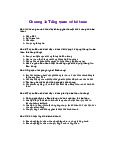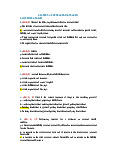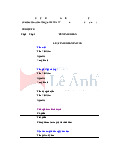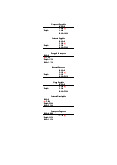







Preview text:
CHAPTER 4. THE RECORDING PROCESS I. MULTIPLE CHOICES
1. (LO 1) K Which of the following statements about an account is true?
a. The left side of an account is the credit or decrease side.
b. An account is an individual accounting record of increases and decreases in specifi c asset,
liability, and owner’s equity items.
c. There are separate accounts for specific assets and liabilities but only one account for owner’s equity items.
d. The right side of an account is the debit or increase side. 2. (LO 1) K Credits:
a. increase both assets and liabilities.
b. decrease both assets and liabilities.
c. increase assets and decrease liabilities.
d. decrease assets and increase liabilities.
3. (LO 1) K Accounts that normally have debit balances are:
a. assets, expenses, and revenues.
b. assets, expenses, and owner’s capital.
c. assets, liabilities, and drawings.
d. assets, expenses, and drawings.
4. (LO 2) K What is the correct sequence of steps in the recording process?
a. Analyzing transactions; preparing a trial balance
b. Analyzing transactions; entering transactions in a journal; posting transactions
c. Entering transactions in a journal; posting transactions; preparing a trial balance
d. Entering transactions in a journal; posting transactions; analyzing transactions 5. (LO 2) AP
Performing services for a customer on account should result in:
a. a decrease in the liability account Accounts Payable and an increase in the revenue account Service Revenue.
b. an increase in the asset account Cash and a decrease in the asset account Accounts Receivable.
c. an increase in the asset account Accounts Receivable and an increase in the liability account Unearned Revenue.
d. an increase in the asset account Accounts Receivable and an increase in the revenue account Service Revenue.
6. (LO 2) AP The purchase of equipment on account should result in:
a. a debit to Equipment and a credit to Accounts Payable.
b. a debit to Equipment Expense and a credit to Accounts Payable.
c. a debit to Equipment and a credit to Cash.
d. a debit to Accounts Receivable and a credit to Equipment. 7. (LO 3) K A ledger:
a. contains only asset and liability accounts.
b. should show accounts in alphabetical order.
c. is a collection of the entire group of accounts maintained by a company.
d. is a book of original entry. 8. (LO 3) K Posting:
a. is normally done before journalizing.
b. transfers ledger transaction data to the journal. Brief Exercises 2-31
c. is an optional step in the recording process.
d. transfers journal entries to ledger accounts.
9. (LO 4) K A trial balance:
a. is a list of accounts with their balances at a specific time.
b. proves that journalized transactions are accurate.
c. will not balance if a correct journal entry is posted twice.
d. proves that all transactions have been recorded.
10. (LO 4) AP A trial balance will not balance if:
a. the collection of an account receivable is posted twice.
b. the purchase of supplies on account is debited to Supplies and credited to Cash.
c. a $100 cash drawing by the owner is debited to Drawings for $1,000 and credited to Cash for $100.
d. a $450 payment on account is debited to Accounts Payable for $45 and credited to Cash for $45. II. EXERCISES
BE2.2 (LO 1) K Identify the normal balance for the following accounts: 1. Prepaid Insurance 5. Utilities Expense 9. Supplies 2. Accounts Payable 6. Owner’s Capital 10. Unearned Revenue 3. Land 7. Equipment 4. Service Revenue 8. Salaries Expense
BE2.3 (LO 1) K For each the following accounts, indicate (a) if the account is an asset,
liability, or owner’s equity account; and (b) whether the account would have a normal debit or credit balance. 1. Accounts Receivable 4. Supplies 7. Prepaid Insurance 2. Rent Expense 5. Unearned Revenue 8. Notes Payable 3. B. Damji, Drawings 6. Service Revenue
BE2.4 (LO 1) K Calculate the account balance for the following accounts:
BE2.5 (LO 1) K For each of the following accounts, indicate (a) the normal balance, (b) the
effect of a debit on the account, and (c) the effect of a credit on the account: 1. Accounts Payable
4. J. Takamoto, Drawings 7. Service Revenue 2. Supplies 5. Prepaid Rent 8. Unearned Revenue
3. J. Takamoto, Capital 6. Utilities Expense
BE2.6 (LO 2) K For each of the following, indicate (a) if the account is an asset, liability, or
owner’s equity account; and (b) whether you would use a debit or credit to record the change:
1. Increase in D. Parmelee, Capital
5. Increase in D. Parmelee, Drawings 2. Decrease in Cash 6. Increase in Equipment
3. Decrease in Notes Payable
7. Increase in Accounts Payable
4. Increase in Rent Expense
8. Increase in Service Revenue
BE2.7 (LO 2) C Levine Legal Services had the following transactions:
1. Cash is paid for the purchase of $439 of office supplies.
2. Customer is billed $1,020 for services provided that day.
3. Equipment with a cost of $2,230 is purchased on account.
4. The current month’s utility bill of $293 is paid in cash.
5. Cash of $750 is received for services provided that day.
6. Cash of $7,100 is received for services to be provided in the next month.
For each transaction, prepare a basic analysis and a debit/credit analysis. Use the following
format, in which the first one has been done for you as an example:
The asset account Cash is decreased by $439. The asset account Basic Analysis Supplies is increased by $439. Debit/Credit
Debits increase assets: debit Supplies $439. Analysis
Credits decrease assets: credit Cash $439.
BE2.8 (LO 2) C Fleming’s Logistics Consulting has the following transactions during August.
Aug.1 Received $17,970 cash from the company’s owner, Barbara Fleming. 4
Paid rent in advance for three months, $4,720. 5
Purchased $625 of office supplies on account. 6
Received $560 from clients for services provided. 17
Billed clients $1,210 for services provided. 27 Paid secretary $980 salary. 29
Paid the company’s owner, Barbara Fleming, $720 cash for personal use.
For each transaction, indicate (a) the basic type of account to be debited and credited (asset,
liability, owner’s equity); (b) the specific accounts to debit and credit (for example, Cash,
Service Revenue, Accounts Payable); and (c) whether each account is increased (+) or
decreased (-), and by what amount. Use the following format, in which the first one has been done for you as an example: 4 5 6 17 27 29
BE2.9 (LO 2) AP Pridham Welding Company had the following transactions for June.
June 1 Tyler Pridham invested $8,430 cash in a small welding business.
2 Bought used welding equipment on account for $2,620.
5 Hired an employee to start work on July 15. Agreed on a salary of $3,760 per month.
17 Billed R. Windl $2,500 for welding work done.
27 Received $1,190 cash from R. Windl for work billed on June 17.
For each transaction, prepare a basic analysis and a debit/credit analysis, and journalize the
transaction. Use the following format, in which the first one has been done for you as an example: June 1 transaction
The asset account Cash is increased by $8,430. The owner’s equity Basic Analysis account
T. Pridham, Capital is increased by $8,430. Debit/Credit
Debits increase assets: debit Cash $8,430. Analysis
Credits increase owner’s equity: credit T. Pridham, Capital $8,430. June 1 Cash 8,430 Journal Entry T. Pridham, Capital 8,430 Invested cash in business.
BE2.10 (LO 2) AP Presented below is information related to Berge Real Estate Agency:
Oct. 1 Lia Berge begins business as a real estate agent with a cash investment of $30,000.
2 Pays rent, $700, on office space.
3 Purchases office equipment for $2,800, on account.
6 Sells a house and lot for Hal Smith; bills Hal Smith $4,400 for realty services performed.
27 Pays $1,100 on the balance related to the transaction of October 3.
30 Receives bill for October utilities, $130 (not paid at this time).
Journalize the transactions. (You may omit explanations.)
BE2.11 (LO 2) AP Using the data in BE2.7 for Levine Legal Services, journalize the
transactions. Assume all of the transactions occurred on August 31.
BE2.12 (LO 2) AP Using the data in BE2.8 for Fleming’s Logistics Consulting, journalize the transactions.
BE2.13 (LO 2) AP Journalize the following transactions of M. Acosta, interior designer, in her first month of business.
Jan. 2 Invested $10,000 cash in business.
3 Purchased a used car for $3,000 cash for use in the business.
9 Purchased supplies on account for $600.
11 Billed customers $2,400 for services performed.
16 Paid $350 cash for advertising.
20 Received $900 cash from customers billed on January 11.
28 Withdrew $1,000 cash for personal use by owner.
BE2.14 (LO 3) AP Tom Rast recorded the following transactions during the month of April: April 3 Cash 3,400 Service Revenue 3,400 16 Rent Expense 700 Cash 700 20 Salaries Expense 250 Cash 250
Post these entries to the Cash T account of the general ledger to determine the ending balance
in cash. The beginning balance in cash on April 1 was $1,600.
BE2.15 (LO 3) AP Using T accounts, post the following journal entries to the general ledger and calculate ending balances. General Journal Date Account titles Debit Credit Sept. 2 Accounts Receivable 4,400 Service Revenue 4,400 4 Cash 2,400 Accounts Receivable 2,400 10 Cash 3,000 Service Revenue 3,000 28 Cash 1,325 Accounts Receivable 1,325
BE2.16 (LO 4) AP From the ledger balances given below, prepare a trial balance for Amaro
Company at June 30, 2021. All account balances are normal.
Accounts Payable $8,100, Cash $5,800, Owner’s Capital $15,000, Owner’s Drawings $1,200,
Equipment $17,000, Service Revenue $10,000, Accounts Receivable $3,000, Salaries
Expense $5,100, and Rent Expense $1,000.
BE2.17 (LO 4) AP Use the ledger balances that follow to prepare a trial balance for Pettipas
Company at April 30, 2021. All account balances are normal. Accounts payable $ 3,300 Prepaid rent $ 800 Accounts receivable 5,000 Rent expense 4,500 C. Pettipas, capital 22,500 Salaries expense 1,000 C. Pettipas, drawings 1,100 Service revenue 8,000 Cash 6,400 Supplies 650 Equipment 14,600 Unearned revenue 250
P2.8B (LO 2, 3, 4) AP Lena Kuznetsova provides coaching and mentoring services to
individuals and companies. She operates the business as a proprietorship, under the name
LVK Coaching Services, which has a December 31 year end. On November 30, 2021, the
company’s general ledger included the following accounts (all accounts have normal balances): Accounts payable $4,245 $31,190 L. Kuznetsova, drawings Accounts receivable 2,110 5,775 Rent expense Advertising expense 1,265 6,310 Salaries expense Cash 3,165 47,963 Service revenue Equipment 17,730 1,340 Supplies Insurance expense 3,388 765 Unearned revenue L. Kuznetsova, capital 19,300
December transactions were as follows:
Dec.1 Paid December rent on her office space, $525.
1 Purchased additional equipment with a manufacturer’s suggested price of $3,270.
After negotiations with the retailer, paid $1,270 cash and signed a note payable for $2,000.
4 Collected $1,880 from customers in payment of their accounts.
7 Paid the $308 monthly insurance premium.
8 Purchased $135 of supplies on account.
10 Paid $2,140 of the accounts payable from November.
12 Finished a coaching contract with a client for $765. The client had paid her in November.
(Hint: In November, Lena had recorded the $765 as a liability, Unearned Revenue. By
finishing the coaching contract, she has “paid” this obligation.)
20 Received $3,480 cash from clients for services provided in December.
21 Paid office expenses of $115.
24 Withdrew $2,860 for personal use.
28 Billed clients $2,280 for coaching services provided in December. These clients will pay in January.
29 Received $560 cash advance from a client for a coaching contract that will start in January.
30 Paid part-time office assistant $655 cash.
31 Made a $170 payment on the note payable. Of this amount, $10 is interest and the
remainder is a principal payment on the note payable. Instructions
a. Using T accounts, enter the November 30 balances in the ledger accounts.
b. Journalize the December transactions.
c. Post the December journal entries to the T accounts. Add new accounts if needed.
d. Prepare a trial balance at December 31, 2021.
e. Prepare an income statement for the month.
f. Prepare a statement of owner’s equity for the month.
g. Prepare a balance sheet as at December 31, 2021.
P2.11B (LO 2, 3, 4) AP Hobson Nolan is a human resources professional who operates a
consulting practice under the name HN Consulting. The company had the following balances
in its general ledger at February 28, 2021: Cash $3,500, Accounts Receivable $14,450, Equipment $15,100, Accounts Payable $18,750, and H. Nolan, Capital $14,300.
The following events and transactions occurred during March 2021.
Mar.1 Borrowed $12,000 cash from the bank, signing a note payable.
2 Paid $13,000 to creditors on account. 3
Paid the monthly insurance premium of $145.
10 Paid the monthly utilities of $550.
16 Collected accounts receivable of $8,000.
18 Paid an additional $5,000 to creditors on account.
30 Office expenses were paid in cash, $580.
31 Consulting services provided in March were for $2,000 cash and $5,000 on account. 31 Paid salaries, $1,650.
31 Paid the bank $555 on the note payable, of which $55 is interest and $500 is a partial payment of the note.
31 Paid March and April’s rent, which totaled $1,900 ($950 per month).
31 Withdrew $1,000 cash for personal use. Instructions
a. Prepare journal entries to record each of the March transactions.
b. Using T accounts, open the required ledger accounts for the transactions that were
journalized, and enter February 28, 2021, balances.
c. Post the journal entries to the accounts in the ledger.
d. Prepare a trial balance as at the end of March.
e. Prepare an income statement for the month.
f. Prepare a statement of owner’s equity for the month.
g. Prepare a balance sheet as at March 31, 2021.




